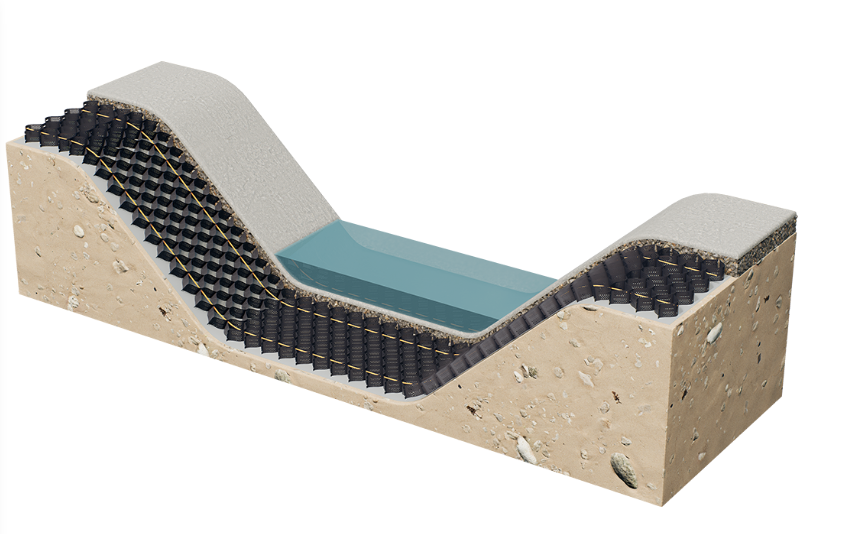- Understanding the Role of Geomembrane Liners in Waste Management
- Innovations in Geomembrane Liners for Water Management
- Geomembrane Liners: A Comprehensive Guide
- The Future of Geomembrane Liners in Civil Engineering
- Geomembrane Liners: Enhancing Landfill Stability
Manager:Alvin Wang
WhatsApp:+62 8983806051
Tel:+86 10-5797-1075
Email:steelwang@okorder.com
Address:3rd Floor, No.2 Building, No.1 Sanlihe Road
What is geocell retaining wall?
In the realm of civil engineering and environmental protection, the term ""geocell retaining wall"" has gained significant traction. But what exactly does it entail, and why is it becoming increasingly popular in slope protection strategies? In this comprehensive guide, we'll delve into the intricacies of geocell slope protection and explore how it's revolutionizing slope stabilization methodologies.

Understanding Geocell Slope Protection
Geocell slope protection involves the utilization of three-dimensional, honeycomb-like structures made from high-density polyethylene (HDPE) or other durable materials. These interconnected cells are filled with soil, aggregate, or concrete and then deployed to reinforce slopes, embankments, and retaining walls. The primary objective of geocell slope protection is to mitigate erosion, control soil displacement, and enhance stability in terrain prone to landslides or erosion.
The Mechanism Behind Slope Protection Geocell
The concept of slope protection geocell revolves around the principle of confinement. By confining the infill material within the cellular matrix, geocells effectively distribute loads and restrain lateral movement. This confinement mechanism significantly improves the load-bearing capacity of the soil, reduces surface erosion, and enhances slope stability. Moreover, the flexibility of geocell structures allows them to adapt to varying terrain contours, making them versatile solutions for slope protection challenges.
Advantages of Geocell Retaining Wall
Geocell retaining walls offer a multitude of advantages over traditional slope stabilization techniques. Firstly, they provide superior erosion control, preventing soil loss and maintaining the integrity of slopes even under harsh environmental conditions. Secondly, geocell structures are lightweight yet incredibly robust, offering high tensile strength and durability. This characteristic makes them ideal for applications in remote or challenging terrains where transportation and installation of heavy materials pose logistical constraints. Additionally, geocell retaining walls are cost-effective, requiring minimal maintenance over their lifespan compared to conventional structures.
Applications of Geocell Slope Protection
The versatility of geocell slope protection renders it suitable for various applications across different industries. From highway embankments and railway slopes to coastal erosion control and mine reclamation, geocell retaining walls offer sustainable solutions to a wide array of slope stability challenges. In urban environments, geocells can be employed for green infrastructure initiatives, such as vegetated retaining walls and slope stabilization in parks or residential areas. Moreover, the modular nature of geocell systems facilitates rapid deployment and customization according to project requirements, making them indispensable tools for engineers and environmentalists alike.
Environmental Benefits of Geocell Retaining Walls
In addition to their functional advantages, geocell retaining walls boast significant environmental benefits. By promoting vegetation growth and minimizing soil disturbance, geocell slope protection contributes to ecosystem restoration and biodiversity conservation. Furthermore, the use of recycled materials in geocell manufacturing reduces reliance on virgin resources and helps mitigate the environmental impact of construction activities. As a result, geocell retaining walls align with sustainable development objectives and promote ecologically responsible engineering practices.
Challenges and Considerations
While geocell slope protection offers compelling advantages, it's essential to acknowledge the challenges and considerations associated with its implementation. Factors such as proper design, adequate site preparation, and quality control during installation are crucial for ensuring the effectiveness and longevity of geocell retaining walls. Additionally, factors such as material selection, load requirements, and environmental conditions must be carefully evaluated to optimize performance and mitigate potential risks. Collaborative efforts between engineers, environmental specialists, and project stakeholders are paramount for addressing these challenges and delivering successful slope protection solutions.

Future Outlook
As the demand for sustainable infrastructure solutions continues to rise, the role of geocell retaining walls in slope protection is poised for further growth and innovation. Advances in material science, manufacturing techniques, and geosynthetic engineering are expected to enhance the performance and versatility of geocell systems, expanding their applicability to diverse terrains and environments. Moreover, ongoing research and development initiatives focused on optimizing design methodologies and addressing site-specific challenges will contribute to the mainstream adoption of geocell slope protection techniques worldwide. Ultimately, the integration of geocell retaining walls into civil engineering practices represents a proactive approach towards resilient infrastructure development and environmental stewardship."






